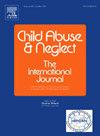Non-suicidal self-harm among adolescents with substantiated childhood maltreatment: Findings from the Norwegian Triple-S Study
IF 3.4
2区 心理学
Q1 FAMILY STUDIES
引用次数: 0
Abstract
Background
Childhood maltreatment (CM) is a well-established risk factor for psychological distress and self-harm in adolescence. However, few studies have examined how specific types of maltreatment, multivictimization, and familial factors jointly contribute to non-suicidal self-harm (NSSH).
Aims
To investigate the prevalence and correlates of NSSH among Norwegian adolescents with substantiated experiences of CM, including associations with specific subtypes, multivictimization, ethnicity, and family history of self-harm.
Method
We analysed self-reported data from 308 adolescents (aged 12–18 years; 81.2 % girls) with substantiated maltreatment experiences who attended a national residential facility for children and young people with experience of abuse and violence between 2016 and 2024. Self-harm behaviours were assessed using validated items adapted from the CASE study. Associations were examined using Poisson regression, adjusting for age and sex.
Results
Overall, 52.8 % reported a history of self-harm, with 35.8 % reporting ≥10 episodes. Girls were more likely to report NSSH than boys (59.3 % vs. 25.0 %), although boys reported an earlier age of onset. One in six participants reported familial self-harm or suicide attempts. Self-harm prevalence increased with the number of maltreatment types experienced, from 42.4 % (one type) to 61.0 % (four or more types). All CM types were associated with high rates of NSSH. Ethnic Norwegian adolescents had higher self-harm prevalence than their immigrant-background peers.
Conclusions
NSSH is alarmingly common among adolescents exposed to CM, particularly among girls and those who have experienced multivictimization. These findings highlight the need for early, developmentally appropriate, and family-inclusive intervention strategies.
证实儿童期遭受虐待的青少年的非自杀性自残:来自挪威Triple-S研究的发现
童年虐待是青少年心理困扰和自我伤害的一个公认的危险因素。然而,很少有研究调查了特定类型的虐待、多重受害和家庭因素如何共同导致非自杀性自我伤害(NSSH)。目的:调查挪威青少年中有CM经历的NSSH患病率及其相关性,包括与特定亚型、多重受害、种族和自我伤害家族史的关系。方法分析308名青少年(12-18岁;2016年至2024年期间,有虐待经历的儿童和青少年在国家寄宿机构接受治疗。使用案例研究中改编的有效项目评估自残行为。使用泊松回归检验相关性,调整年龄和性别。结果52.8%的受访学生有自残史,其中35.8%的受访学生自残≥10次。女孩比男孩更有可能报告NSSH(59.3%比25.0%),尽管男孩报告的发病年龄更早。六分之一的参与者报告了家庭自残或自杀企图。自残患病率随着遭受虐待类型的增加而增加,从42.4%(一种类型)增加到61.0%(四种或更多类型)。所有CM类型均与高NSSH发生率相关。挪威族裔青少年的自残率高于移民背景的同龄人。结论在接触CM的青少年中,尤其是女孩和多次受害的青少年中,snssh非常普遍。这些发现强调了早期、适合发育和家庭包容的干预策略的必要性。
本文章由计算机程序翻译,如有差异,请以英文原文为准。
求助全文
约1分钟内获得全文
求助全文
来源期刊

Child Abuse & Neglect
Multiple-
CiteScore
7.40
自引率
10.40%
发文量
397
期刊介绍:
Official Publication of the International Society for Prevention of Child Abuse and Neglect. Child Abuse & Neglect The International Journal, provides an international, multidisciplinary forum on all aspects of child abuse and neglect, with special emphasis on prevention and treatment; the scope extends further to all those aspects of life which either favor or hinder child development. While contributions will primarily be from the fields of psychology, psychiatry, social work, medicine, nursing, law enforcement, legislature, education, and anthropology, the Journal encourages the concerned lay individual and child-oriented advocate organizations to contribute.
 求助内容:
求助内容: 应助结果提醒方式:
应助结果提醒方式:


